Abstract
Little information is available on the relationship between occupational exposure to inorganic arsenic in coal fly ash and urinary excretion of arsenic metabolites. This study ws undertaken in a coal-fired power plant in Slovakia during a routine maintenance outage. Arsenic was measured in the breathing zone of workers during 5 consecutive workdays, and urine samples were obtained for analysis of arsenic metabolites--inorganic arsenic (Asi), monomethylarsonic acid (MMA), and dimethylarsinic acid (DMA)--prior to the start of each shift. Results from a small number of cascade impactor air samples indicated that approximately 90% of total particle mass and arsenic was present in particle size fractions >/= 3.5 micron. The 8-hr time-weighted average (TWA) mean arsenic air concentration was 48.3 microg/m3 (range 0.17-375.2) and the mean sum of urinary arsenic (SigmaAs) metabolites was 16.9 microg As/g creatinine (range 2.6-50.8). For an 8-hr TWA of 10 microg/m3 arsenic from coal fly ash, the predicted mean concentration of the SigmaAs urinary metabolites was 13.2 microg As/G creatinine [95% confidence interval (CI), 10.1-16.3). Comparisons with previously published studies of exposure to arsenic trioxide vapors and dusts in copper smelters suggest that bioavailability of arsenic from airborne coal fly ash (as indicated by urinary excretion) is about one-third that seen in smelters and similar settings. Arsenic compound characteristics, matrix composition, and particle size distribution probably play major roles in determining actual uptake of airborne arsenic.
Full text
PDF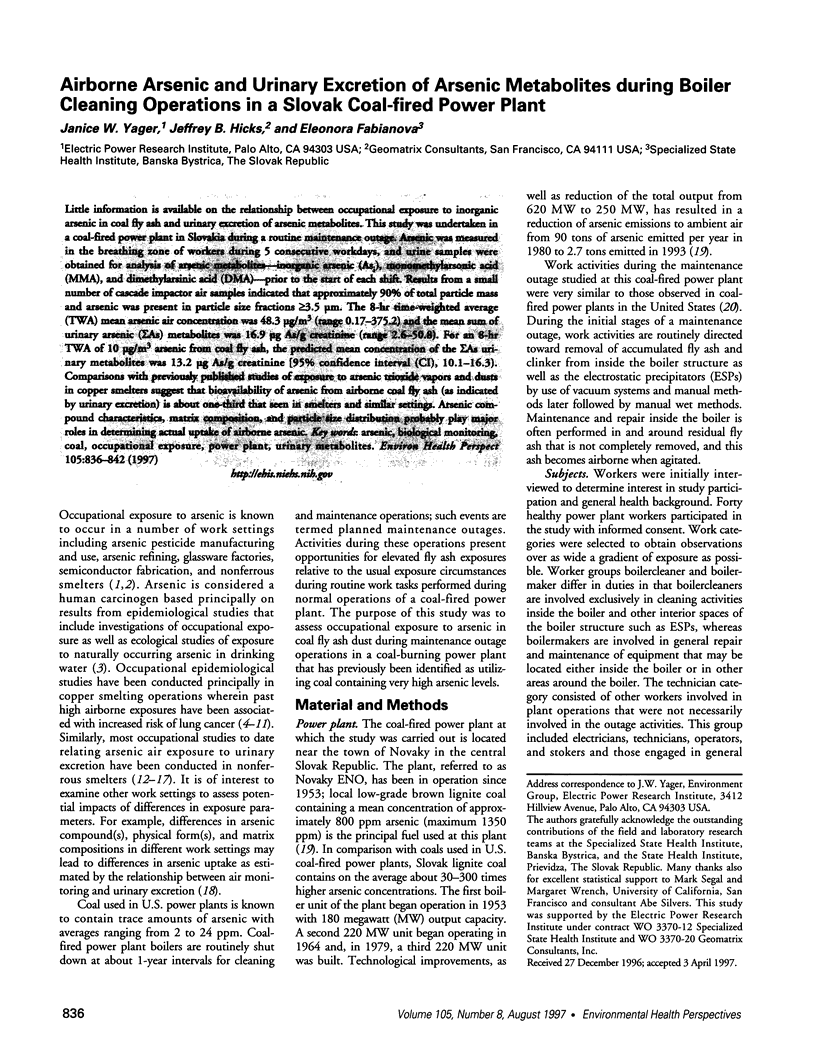
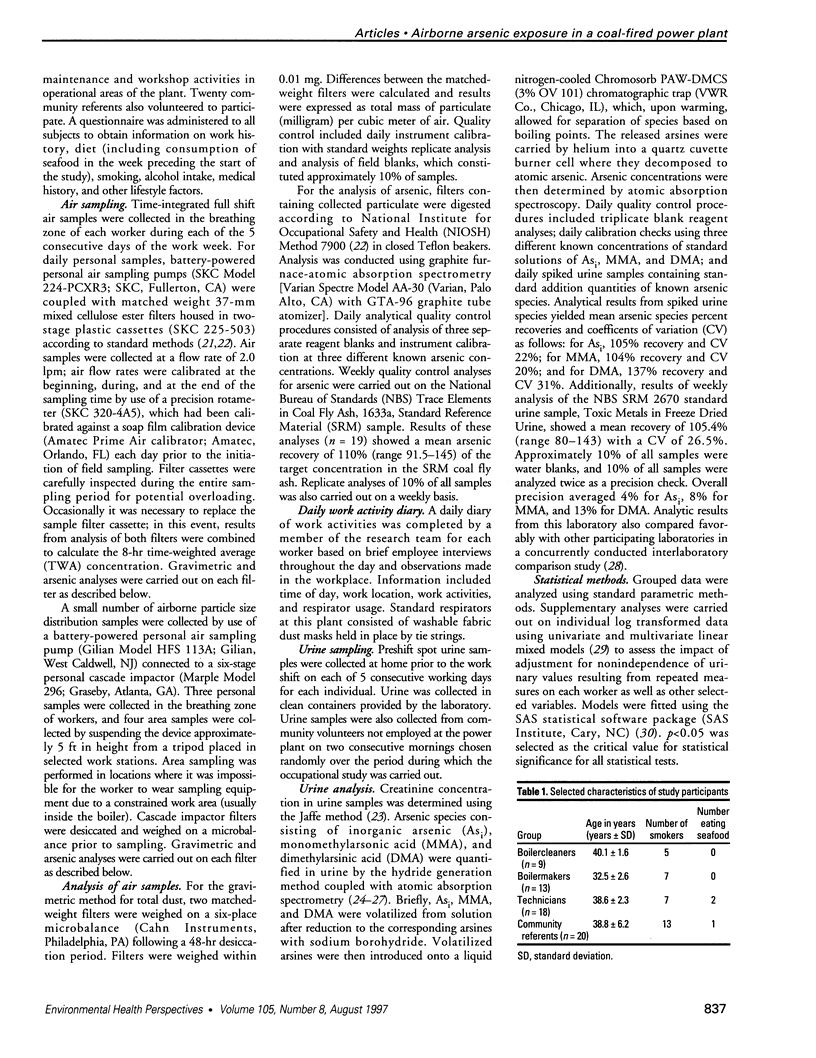
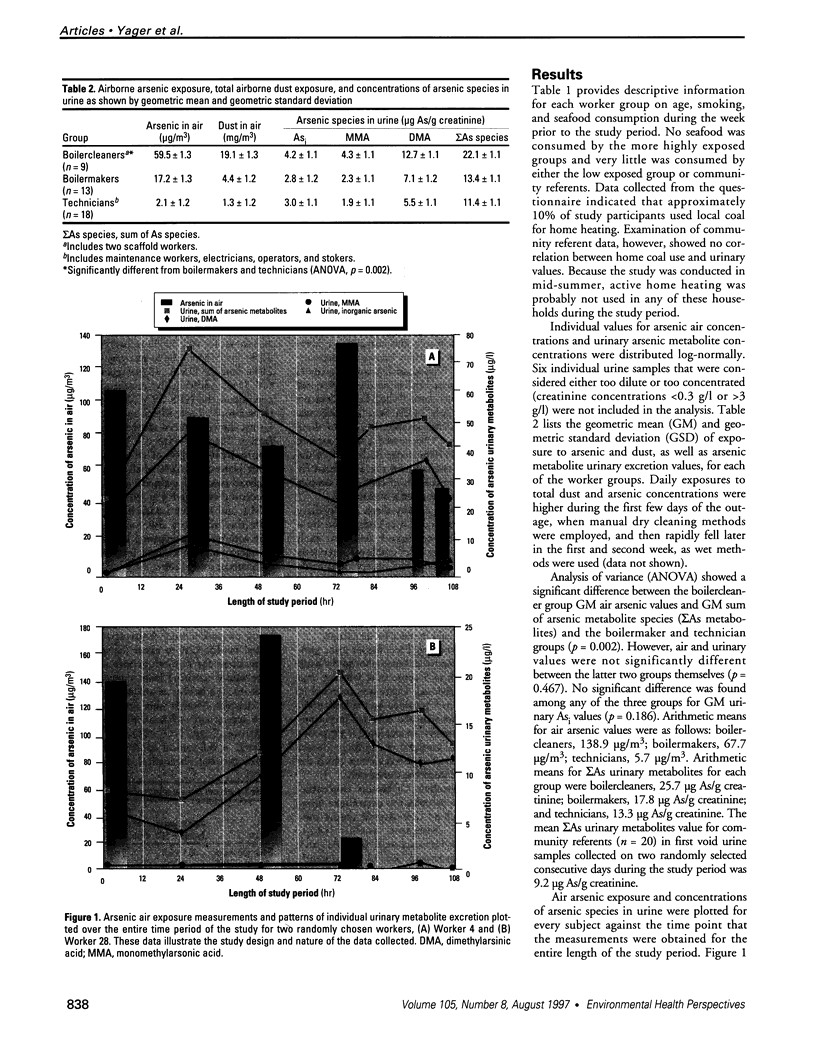
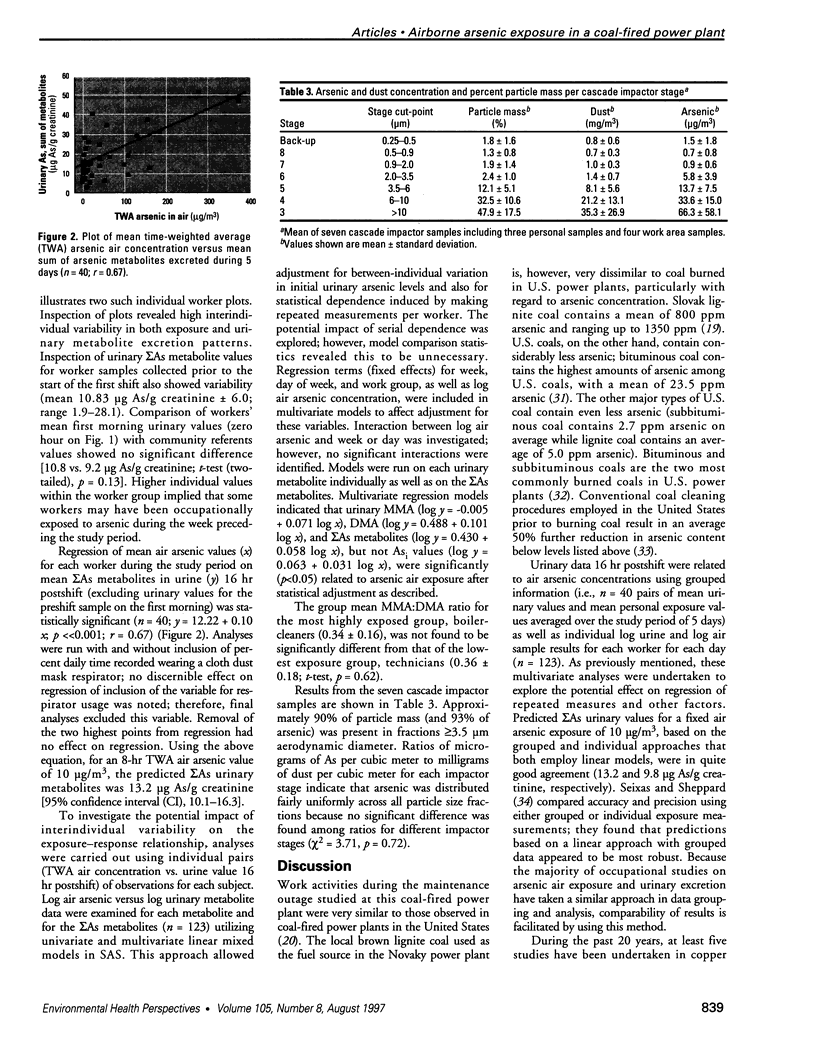
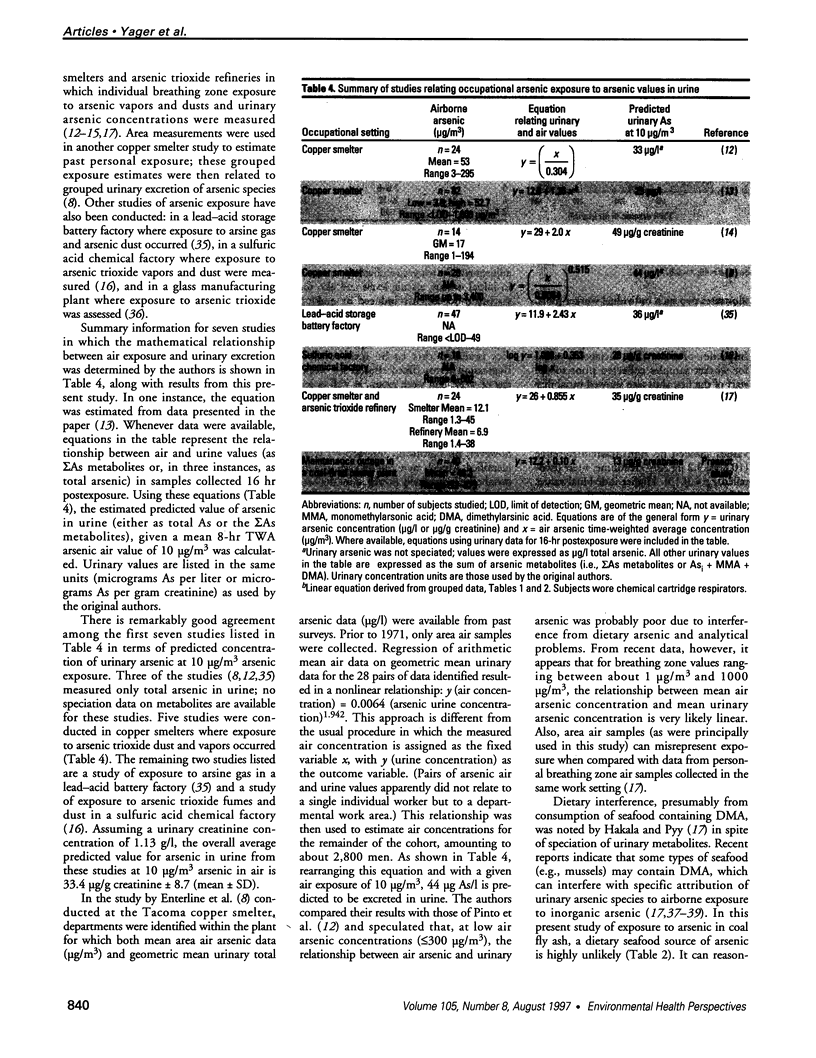

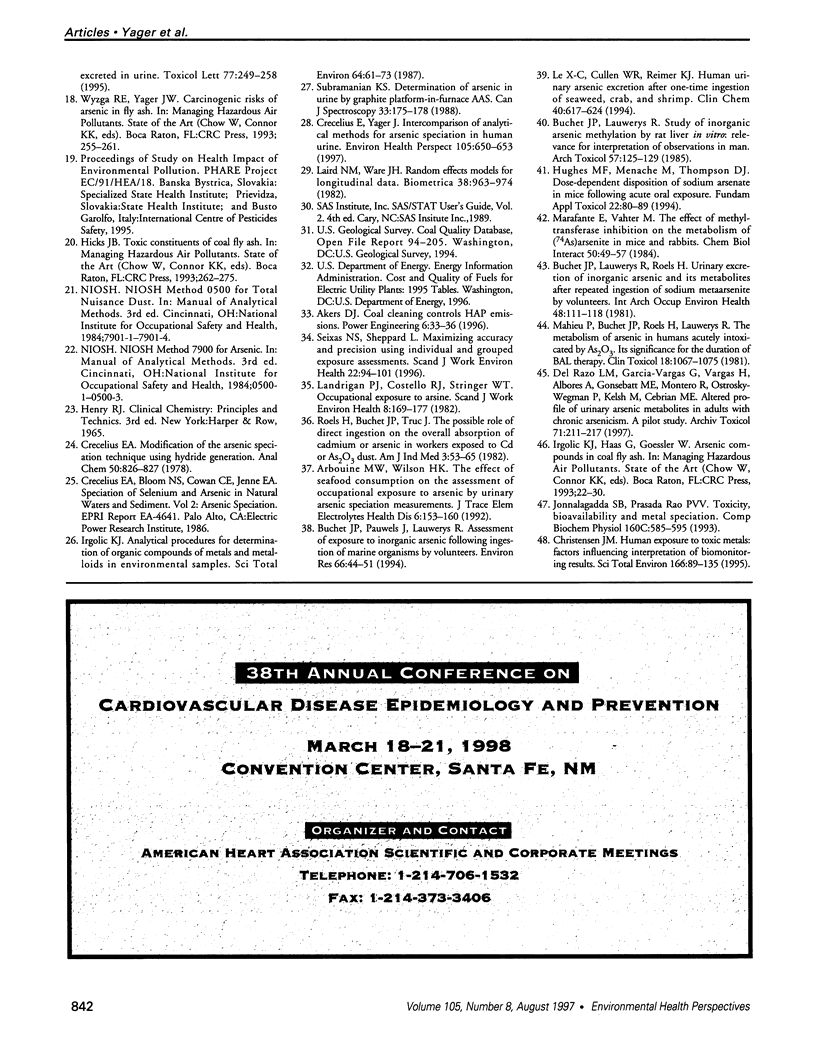
Images in this article
Selected References
These references are in PubMed. This may not be the complete list of references from this article.
- Arbouine M. W., Wilson H. K. The effect of seafood consumption on the assessment of occupational exposure to arsenic by urinary arsenic speciation measurements. J Trace Elem Electrolytes Health Dis. 1992 Sep;6(3):153–160. [PubMed] [Google Scholar]
- Buchet J. P., Lauwerys R., Roels H. Urinary excretion of inorganic arsenic and its metabolites after repeated ingestion of sodium metaarsenite by volunteers. Int Arch Occup Environ Health. 1981;48(2):111–118. doi: 10.1007/BF00378431. [DOI] [PubMed] [Google Scholar]
- Buchet J. P., Lauwerys R. Study of inorganic arsenic methylation by rat liver in vitro: relevance for the interpretation of observations in man. Arch Toxicol. 1985 Jun;57(2):125–129. doi: 10.1007/BF00343122. [DOI] [PubMed] [Google Scholar]
- Buchet J. P., Pauwels J., Lauwerys R. Assessment of exposure to inorganic arsenic following ingestion of marine organisms by volunteers. Environ Res. 1994 Jul;66(1):44–51. doi: 10.1006/enrs.1994.1043. [DOI] [PubMed] [Google Scholar]
- Christensen J. M. Human exposure to toxic metals: factors influencing interpretation of biomonitoring results. Sci Total Environ. 1995 Apr 21;166:89–135. doi: 10.1016/0048-9697(95)04478-j. [DOI] [PubMed] [Google Scholar]
- Crecelius E., Yager J. Intercomparison of analytical methods for arsenic speciation in human urine. Environ Health Perspect. 1997 Jun;105(6):650–653. doi: 10.1289/ehp.97105650. [DOI] [PMC free article] [PubMed] [Google Scholar]
- Del Razo L. M., García-Vargas G. G., Vargas H., Albores A., Gonsebatt M. E., Montero R., Ostrosky-Wegman P., Kelsh M., Cebrián M. E. Altered profile of urinary arsenic metabolites in adults with chronic arsenicism. A pilot study. Arch Toxicol. 1997;71(4):211–217. doi: 10.1007/s002040050378. [DOI] [PubMed] [Google Scholar]
- Enterline P. E., Day R., Marsh G. M. Cancers related to exposure to arsenic at a copper smelter. Occup Environ Med. 1995 Jan;52(1):28–32. doi: 10.1136/oem.52.1.28. [DOI] [PMC free article] [PubMed] [Google Scholar]
- Enterline P. E., Henderson V. L., Marsh G. M. Exposure to arsenic and respiratory cancer. A reanalysis. Am J Epidemiol. 1987 Jun;125(6):929–938. doi: 10.1093/oxfordjournals.aje.a114631. [DOI] [PubMed] [Google Scholar]
- Enterline P. E., Marsh G. M. Cancer among workers exposed to arsenic and other substances in a copper smelter. Am J Epidemiol. 1982 Dec;116(6):895–911. doi: 10.1093/oxfordjournals.aje.a113492. [DOI] [PubMed] [Google Scholar]
- Hughes M. F., Menache M., Thompson D. J. Dose-dependent disposition of sodium arsenate in mice following acute oral exposure. Fundam Appl Toxicol. 1994 Jan;22(1):80–89. doi: 10.1006/faat.1994.1011. [DOI] [PubMed] [Google Scholar]
- Jonnalagadda S. B., Rao P. V. Toxicity, bioavailability and metal speciation. Comp Biochem Physiol C. 1993 Nov;106(3):585–595. doi: 10.1016/0742-8413(93)90215-7. [DOI] [PubMed] [Google Scholar]
- Järup L., Pershagen G. Arsenic exposure, smoking, and lung cancer in smelter workers--a case-control study. Am J Epidemiol. 1991 Sep 15;134(6):545–551. doi: 10.1093/oxfordjournals.aje.a116128. [DOI] [PubMed] [Google Scholar]
- Järup L., Pershagen G., Wall S. Cumulative arsenic exposure and lung cancer in smelter workers: a dose-response study. Am J Ind Med. 1989;15(1):31–41. doi: 10.1002/ajim.4700150105. [DOI] [PubMed] [Google Scholar]
- Laird N. M., Ware J. H. Random-effects models for longitudinal data. Biometrics. 1982 Dec;38(4):963–974. [PubMed] [Google Scholar]
- Landrigan P. J., Costello R. J., Stringer W. T. Occupational exposure to arsine. An epidemiologic reappraisal of current standards. Scand J Work Environ Health. 1982 Sep;8(3):169–177. doi: 10.5271/sjweh.2478. [DOI] [PubMed] [Google Scholar]
- Le X. C., Cullen W. R., Reimer K. J. Human urinary arsenic excretion after one-time ingestion of seaweed, crab, and shrimp. Clin Chem. 1994 Apr;40(4):617–624. [PubMed] [Google Scholar]
- Mahieu P., Buchet J. P., Roels H. A., Lauwerys R. The metabolism of arsenic in humans acutely intoxicated by As2O3. Its significance for the duration of BAL therapy. Clin Toxicol. 1981 Sep;18(9):1067–1075. doi: 10.3109/15563658108990336. [DOI] [PubMed] [Google Scholar]
- Marafante E., Vahter M. The effect of methyltransferase inhibition on the metabolism of [74As]arsenite in mice and rabbits. Chem Biol Interact. 1984 Jun;50(1):49–57. doi: 10.1016/0009-2797(84)90131-5. [DOI] [PubMed] [Google Scholar]
- Offergelt J. A., Roels H., Buchet J. P., Boeckx M., Lauwerys R. Relation between airborne arsenic trioxide and urinary excretion of inorganic arsenic and its methylated metabolites. Br J Ind Med. 1992 Jun;49(6):387–393. doi: 10.1136/oem.49.6.387. [DOI] [PMC free article] [PubMed] [Google Scholar]
- Pinto S. S., Enterline P. E., Henderson V., Varner M. O. Mortality experience in relation to a measured arsenic trioxide exposure. Environ Health Perspect. 1977 Aug;19:127–130. doi: 10.1289/ehp.7719127. [DOI] [PMC free article] [PubMed] [Google Scholar]
- Pinto S. S., Varner M. O., Nelson K. W., Labbe A. L., White L. D. Arsenic trioxide absorption and excretion in industry. J Occup Med. 1976 Oct;18(10):677–680. doi: 10.1097/00043764-197610000-00009. [DOI] [PubMed] [Google Scholar]
- Roels H., Buchet J. P., Truc J., Croquet F., Lauwerys R. The possible role of direct ingestion on the overall absorption of cadmium or arsenic in workers exposed to CdO or As2O3 dust. Am J Ind Med. 1982;3(1):53–65. doi: 10.1002/ajim.4700030108. [DOI] [PubMed] [Google Scholar]
- Seixas N. S., Sheppard L. Maximizing accuracy and precision using individual and grouped exposure assessments. Scand J Work Environ Health. 1996 Apr;22(2):94–101. doi: 10.5271/sjweh.116. [DOI] [PubMed] [Google Scholar]
- Smith T. J., Crecelius E. A., Reading J. C. Airborne arsenic exposure and excretion of methylated arsenic compounds. Environ Health Perspect. 1977 Aug;19:89–93. doi: 10.1289/ehp.771989. [DOI] [PMC free article] [PubMed] [Google Scholar]
- Vahter M., Friberg L., Rahnster B., Nygren A., Nolinder P. Airborne arsenic and urinary excretion of metabolites of inorganic arsenic among smelter workers. Int Arch Occup Environ Health. 1986;57(2):79–91. doi: 10.1007/BF00381375. [DOI] [PubMed] [Google Scholar]
- Welch K., Higgins I., Oh M., Burchfiel C. Arsenic exposure, smoking, and respiratory cancer in copper smelter workers. Arch Environ Health. 1982 Nov-Dec;37(6):325–335. doi: 10.1080/00039896.1982.10667586. [DOI] [PubMed] [Google Scholar]
- Yamauchi H., Takahashi K., Mashiko M., Yamamura Y. Biological monitoring of arsenic exposure of gallium arsenide- and inorganic arsenic-exposed workers by determination of inorganic arsenic and its metabolites in urine and hair. Am Ind Hyg Assoc J. 1989 Nov;50(11):606–612. doi: 10.1080/15298668991375236. [DOI] [PubMed] [Google Scholar]





